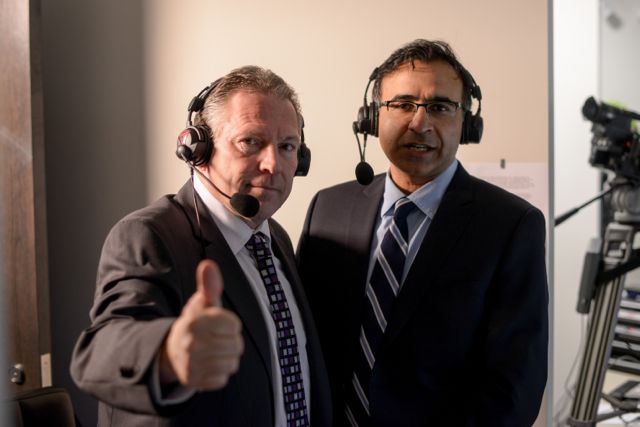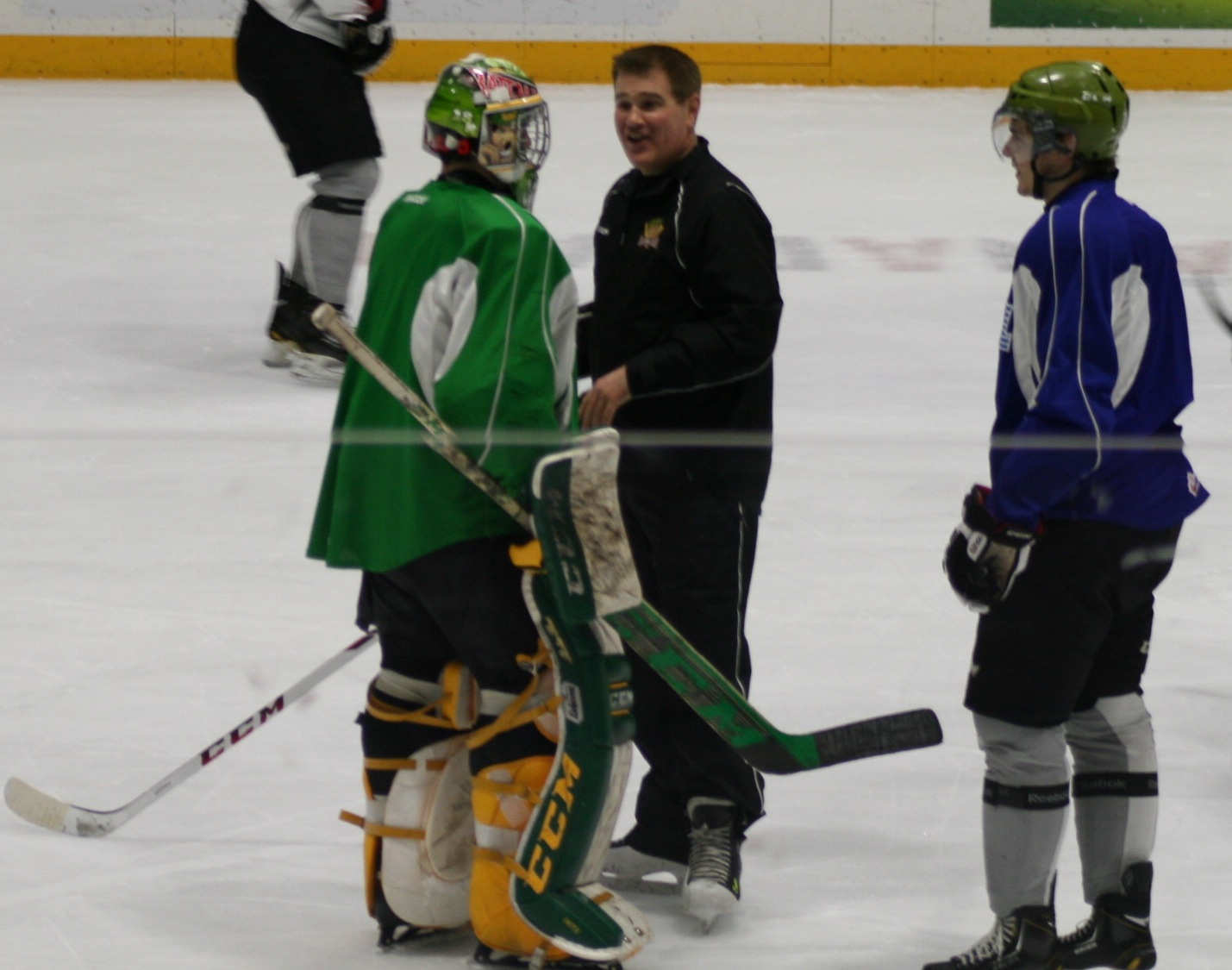"Bluelines: Summer Edition" is written by Ranjan Rupal (right), the play-by-play voice, and Greg Theberge (left), a former Memorial Cup winner and Washington Capitals defenseman and hockey analyst for The OHL Tonight on TVCogeco.
As a child I was quite taken by the notion of the masked hero.
While Spiderman battled villains on a daily basis in the comics pages of the Toronto Star, Batman ka-pow!’d gangs of ne’er-do-wells on TV after school and, on Saturdays, the Lone Ranger and Tonto galloped away at breakneck speed.
At about the same time, I was stopped cold by a photo of a masked Ken Dryden in the Star sports pages, the larger than life goalie leaning on his stick, staring into eternity.
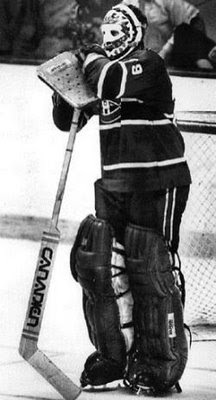 The impression that photo made was indellible, the die cast at that very moment: I would forever be...a goalie guy.
The impression that photo made was indellible, the die cast at that very moment: I would forever be...a goalie guy.
I recall studying goalies and spending considerable time ruminating about their masks, their sticks, and their pads. I cut out newspaper photographs of goalies, and I recall one in particular: Wayne Thomas laid out in his crease, lunging with tremendous effort, striving to snare a puck that appeared to be rolling off the very tip of his trapper. I would think about such saves, and marvel at the panache demonstrated in making those saves. As an avid drawer, I would try to sketch these goalies, in pencil, erasing, and re-erasing, drawing then re-drawing the angle of each pad – they had to be just right. Then there was the matter of the net, the happy chore of meticulous cross thatching, as if I were the netter himself, draping it behind a Leafs' or Canadiens’ goaltender whose arms were outstretched and whose legs were split wide. However, only when the scene had been adequately staged, with the defenseman tying up his man in front, the boards and glass installed, would the actual puck enter the fray, a solitary black rectangle headed, more often than not, to an unprotected area of thatch beyond a haplessly outstretched trapper.
The mad fascination persisted through the seventh grade, when I committed to a drawing of Ken Dryden for my art project, standing as he did, leaning on his stick. After several weeks of dedicated effort, I would return to each art class, obtain my work-in-progress from the back room, and proceed to add more levels of intricate detail. As the drawing took form, I came to know Ken Dryden rather precisely, and he seemed just on the verge of adjusting his mask and resuming his crouch to await the draw. Then one day, to my great dismay, I arrived at art class to find that Ken Dryden was gone. The goalie, the Forum, the fans, everything, had vanished...without a trace.
Undeterred, and driven by this passion, I turned to gearing up and playing some, first on the street, and then on the ice, and I've been around long enough to know that you’re either a goalie guy or you’re not, and those in the latter bunch just don't seem to get it.
Goalie guys are like Harley guys, or fishing guys, or hunting guys. You get enough of them together, and you’re bound to have a good time. Recently I had the opportunity to talk with a goalie guy – a great goalie guy actually – by the name of Rob Beatty. Not a lot of people have heard of Rob Beatty unless they’ve studied the North Bay Battalion game day program, but there he is: Goaltending Coach - sandwiched between Assistant Coach Steve Chabbert and Assistant General Manager Matt Rabideau.
I’ve talked to Rob a few times over the past couple of seasons, usually in the media lounge at Memorial Gardens, or in the press gallery adjacent to the TVCogeco broadcast booth, and though he doesn’t have a whole lot of time, he makes you feel as if he’s got all the time in the world.
As goalie guys, Rob and I speak the same language…kind of. In terms of goaliespeak, I plod along with the equivalent of Grade 5 public school French, while Rob is a master of goaliespeak, shifting through the gears of its terminology, inventing some of it perhaps, with effortless grace.
I figured summer would be a good time to catch up with Rob, and allow Bluelines readers a rare glimpse into the secret life of goalies. So even if you’re not a one now, stick around, and you just might become a goalie guy yourself…
Ranjan: Rob, let’s begin with a shot from the point…we’ve all heard of Francois Allaire, and Jimmy Waite, a couple of accomplished goaltending coaches at the NHL level…what exactly does a goaltending coach do?
Rob Beatty: For my part, what we do is function as a skills coach, Ranjan, breaking down the key technical components of goaltending, and working with our goaltenders to refine those; looking at ways we can move our bodies more efficiently and effectively; keeping it square longer; and going over drills to make our footwork enhance that.
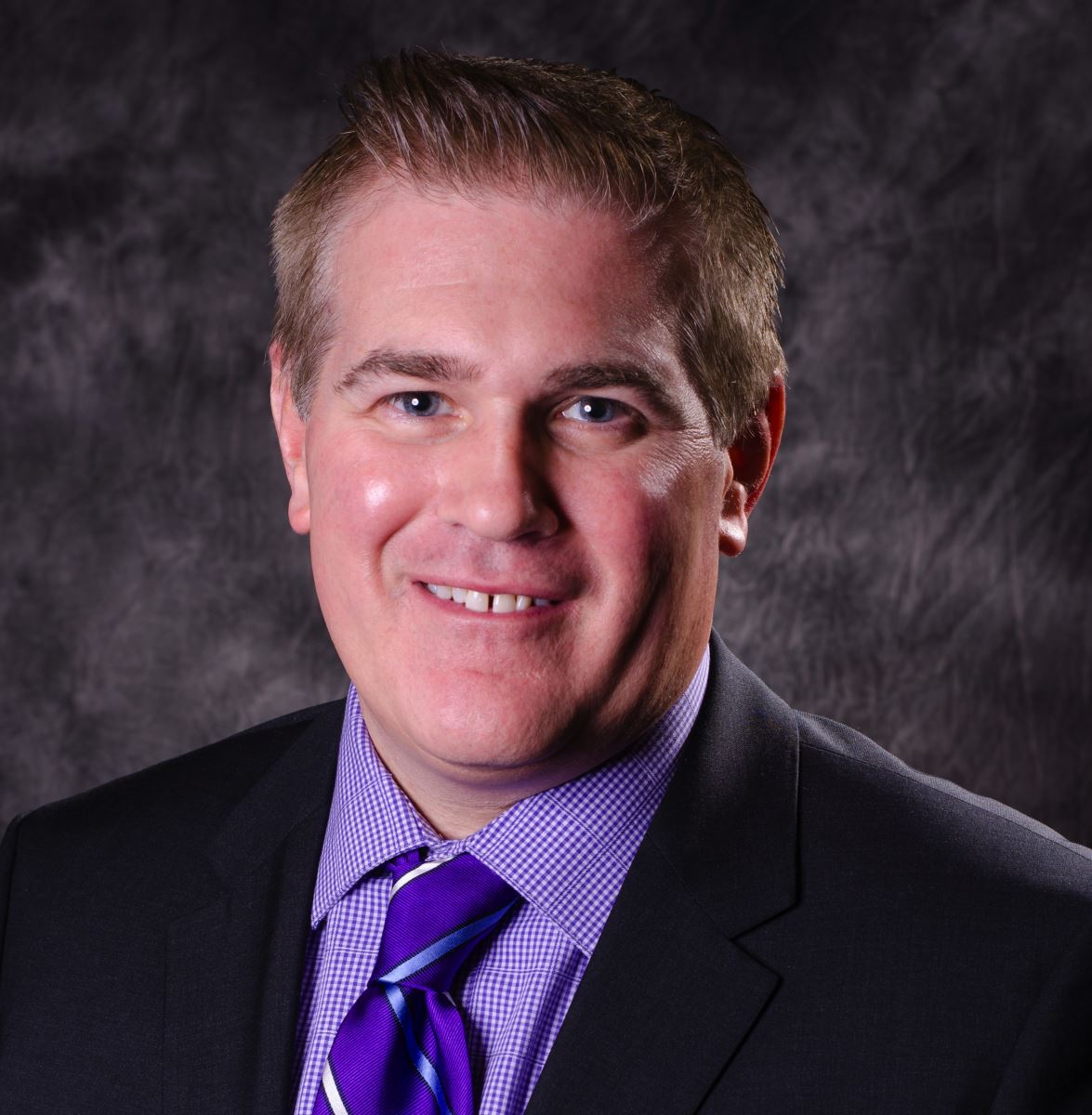
Today’s game, for me, is mostly about footwork and edges, and getting to our spot in a big position, and then working from there, rather than looking at that Francois Allaire approach where you came over in a big, blocking position and you could work from the down position.
I’ve been fortunate to be on an advisory panel for the last two years with Rick Wamsley, working with other OHL goaltending coaches and professionals across Canada, on revising what we do as goaltending coaches; what we’re teaching, and that national approach…looking at what Finland does.
A number of our colleagues have gone to Finland, looking at what they do, and looking at what Sweden does, and looking at what all those other places do, because they seem to be producing goaltenders that are taking up a lot more time when it comes to NHL play than the Canadian or North American goaltender.
Ranjan: What are you seeing in Finland and Sweden right now?
Rob Beatty: What we’re finding is that they’re letting goaltenders be athletic. They’re letting goaltenders play their styles. They’re letting them be natural athletes, rather than a prescribed robot who blocks, or a prescribed robot who has to come over in certain positions.
The information we’ve been able to ascertain from Finland and Sweden is about how hard they work at getting their goaltenders to be really efficient skaters first, and morphing into good goaltenders, and the amount of time that they spend working on skating, in relation to being in net facing pucks. At the younger age groups you’re doing more lengths, laps, circles, pivots…much more than you’re stopping shots. I’m a big advocate of we’ve got to get our feet going, we’ve got to keep upright as long as you can. You can ask my goalies how many times they get in the net! We’re doing these stupid footwork drills again! You can ask the kids that I work with in the GTA area about how often we focus on footwork. We do so many skating drills right now.
Ranjan: Did that transition occur during Jake Smith’s era, so that he might have been taught one way in minor hockey, and has now learned a different style?
Rob Beatty: Yeah, I think you’re watching a small evolution. I think if you watch the goaltenders in the OHL now, it’s not about technically perfect saves all the time. It’s about getting to spots in square positions and then working from that. I think lots of goaltender coaches are spending more and more time on footwork and on edge work than we’ve ever had before, getting those legs stronger for pushes, getting those hips able to really rotate and pivot more quickly and efficiently, and getting them back square.
.jpg)
The goalie craft has evolved steadily since the freestyling days of Mike Palmateer
When you and I played goal, we’ve relied on skate saves, and the one pad up, and making saves using only one particular piece of our body. Now it’s getting over there, and getting square and having a blocker available with a body behind it, or a pad behind it, or a catcher available, centering on the puck and moving over. The transition going on is all about your movement: watch how square Carey Price gets, and how early he gets there. The same can be said for Henrik Lundqvist. Their footwork is so efficient.
Ranjan: What would you say about Patrick Roy’s style? His style evolved dramatically from the time he was first in the League to when he retired...
Rob Beatty: I think you’re right. He was a real Francois Allaire student, if memory serves me correctly; he worked under him for a long, long time. He found out you didn’t have to play down all the time, you could rely on your feet to get you places. The evolution of Patrick may have been a foreshadowing of where goaltending has gone in North America. You can come over in stand-up positions and you can now rely on your feet to get you places rather than coming over sliding.
I’m not saying that sliding doesn’t have a role in our game, but I’m saying you get there square, and then you react to that first shot, and maybe those second shots now are slides, but the first time is coming over and blocking.
Now it’s all about catching and controlling. You don’t want that first shot going anywhere but below the red line and into the corner, or in your chest and you’re gobbling it up, or in your blocker. There’s a real focus on that rebound control. We’ve watched goaltenders and the focus is on catching, even from my youngest goalie schools, in my youngest students, up to the Jake Smiths, and when I work with some of the pro guys. The emphasis we place on that first catch and control is unbelievably focused now.
Ranjan: Tell me how you became the Battalion’s goaltending coach…
Rob Beatty: Originally I’d done a lot of work with the OMHA and Hockey Canada in their Under-17 program, being one of the evaluators for that. In 2011 there was an opportunity when Stan Butler happened to call me and asked me if I’d be interested in coming out. This was in Brampton, and I said sure. I had the luxury of working with some pretty talented kids and I liked the opportunity of working at the major junior level. And so the marriage was born, and so far it’s been good. I’ve had some great goaltenders to work with in Matej Machovsky and Jake Smith.
Ranjan: Describe your approach with Jake Smith…
Rob Beatty: Jake’s always had that knock on him about being too small, playing too compact, and what Jake and I continue work on is keeping the core tall, and getting over standing up first, and then reacting to the puck, rather than going down and coming over to the spot in that down position. I want to keep Jake’s shoulders up, and square, to the shooters as long as he can. I want that spine angle not focused on the ice, but focused on the shooter. I want Jake’s shoulders to get in the way more than having to rely on his hands to do all the work.
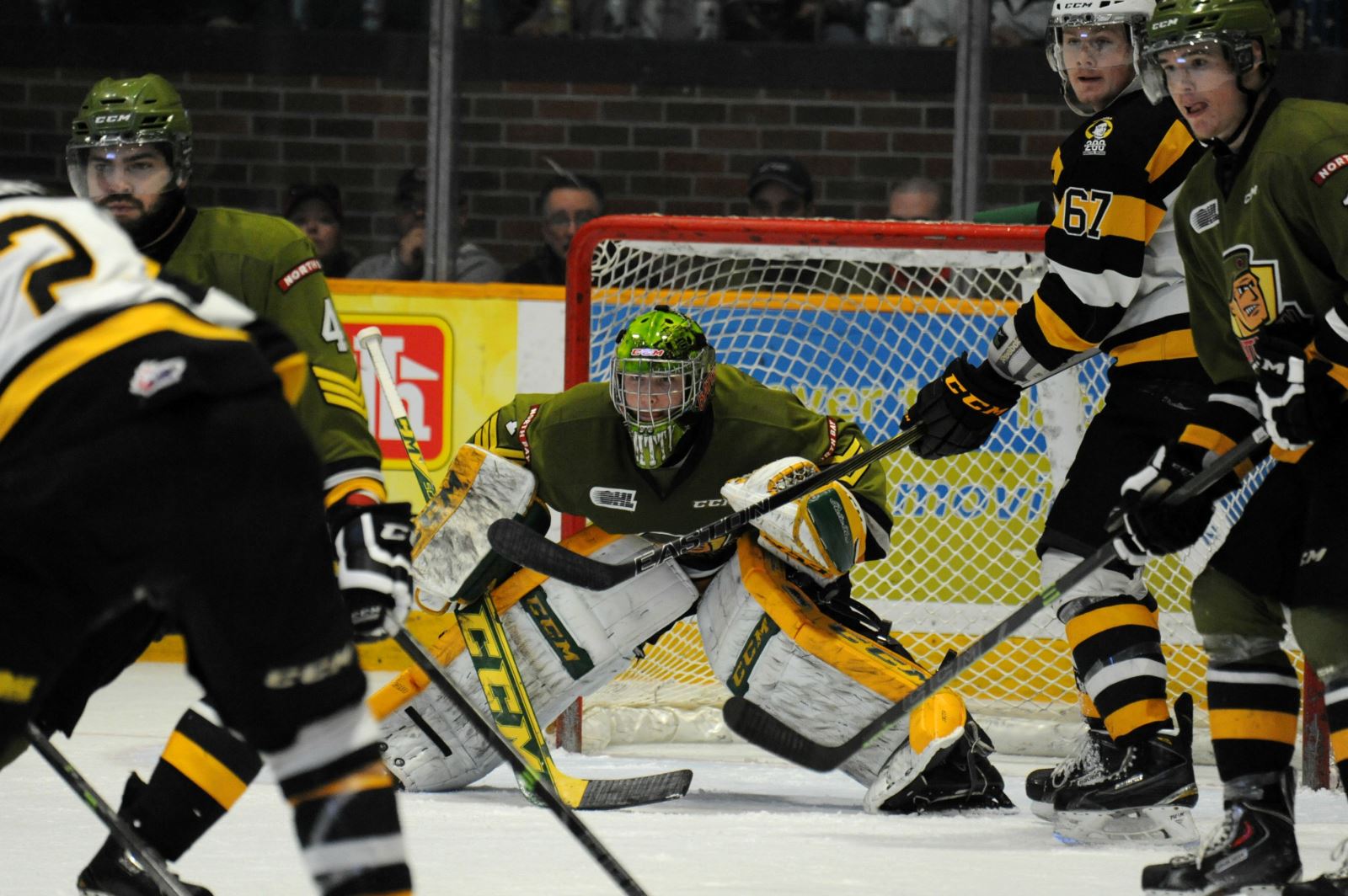
A technically sound Jake Smith peers through traffic during the 2014-15 playoffs
We’ve got to get him less active sometimes. Jake’s an incredible athlete, a really, really active goaltender, and at times, I’m sure that you’ve seen from the broadcast booth, he can get over active, and get a little bit outside his post. We try to mitigate that, and that alludes to my philosophy. I want both Jakes to play the style they want to play. I don’t want to turn them into Carey Price; I don’t want to turn them into Henrik Lundqvist. I want Smitty to play how Jake Smith plays; and Jake Kment to play how Jake Kment plays.
Ranjan: Jake Smith has always been solid and dependable, spectacular at times, and rarely has two subpar outings in a row. So, to the untrained eye, is it possible he was no different this season than in 2014, when he took the Battalion to the OHL finals? In other words, was there actually improvement over last year?
Rob Beatty: Each year I think he’s grown as a goaltender. I think he became more patient last year…way more patient. I think you have to be patient too, knowing that a lot of these shooters you’re going to face are going to figure it out, especially the good ones. There are shooters in the League who now know who and what Jake Smith is, and feel they know where they can expose him, and Jake, as a goaltender, has to be far more patient now.
Being able to close those holes, close that gap…that comes with maturity. You see this evolution in an athlete. All of a sudden they get more mature, and their skill set becomes increasingly more efficient and effective. This year I’d love to see Jake continue to be consistently less active in net. Sometimes I think he thinks he’s got to everything back there. But the thinking should be all I got to do is get to my spots.
As one of my goalie coaches, Jamie Storr’s dad Jim, would always say, “As you get up in the levels, surprisingly, as a goaltender you’ve got to do less and less, because your defensemen get better, and your forwards get better, and they get more efficient.”
Ranjan: Despite being a top goaltender in the League, Jake Smith’s save percentage dipped below .900 toward the end of the season, yet he posts a career-best .927 in a deep playoff run. How do you explain that?
Rob Beatty: I think there are two things. One is the experience from last year. Jake had a lot of time to be nervous when they went to the Finals in 2014. I think he could draw on that experience. I think that’s one of the things that Jake did, was to understand the highs and the lows, and what it’s going to take.
The other thing is he saw Barrie the year before. He saw Oshawa the year before. When you have familiarity with those two teams consistently throughout the year, as well as the previous playoffs, you get that fire in the belly that I want to do this again, and I want to show the scouts that I’m as good as Mackenzie Blackwood; that I’m as good as Kenny Appleby.
For a guy like Jake who's just trying to find the third page sometimes, and Jake’s been an underdog the entire way up, and he loves that role, he has that fire in his belly to say, “You know what? You’re not going to outplay me!” He has the ability to turn that into performance.
Ranjan: Is that a motivator going into his OA year?
Rob Beatty: 100%. The way I know Jake that’s one of the things he loves to get into the net and see a Spencer Martin there and say, “I’m going to win this for my team, and I’m going to outplay the goalie at the other end.”
Ranjan: You mentioned Spencer Martin, a 6’-3” goaltender for the Mississauga Steelheads who will likely be in Colorado’s system in September. Despite the notion that says you have to be 6’-3” to be an NHL goaltending prospect, the Montreal Canadiens developed both Jaro Halak and Dustin Tokarski, both listed at 5’-11”…
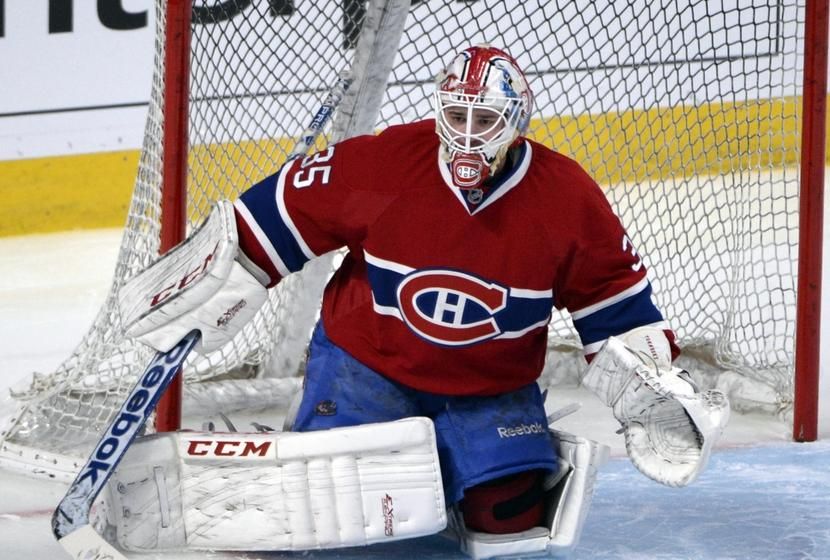
Size doesn't matter: Former Spokane Chiefs (WHL) goaltender Dustin Tokarski
Rob Beatty: I think hopefully that’s the changing philosophy of Canadian goalie coaches and hopefully that morphs into the scouts, and morphs into the people who are putting in the program of excellence for the next generation of goaltenders, as long as you have certain abilities, and you’re able to rely on your feet to get you to your spots and get you as square as you can.
The 6’-4”, 6’-3”, 6’-2” keepers, although they still have a role in our game, we’ve broadened that continuum to include the 5’-10” and 5’-11” guys. I would love to see Jake Smith get an opportunity at the next level, because I think nine times out of 10, and I don’t care whether it’s Spencer Martin, or Kenny Appleby, or I could list 5 other goaltenders, nine times out of 10, when he plays those guys, he outperforms them, and that, at the end of the day, is my barometer as a goaltending coach.
Ranjan: Jake Smith played 56 games last season, one wonders if fatigue may have been a factor toward the end of the season, in a tight playoff race with Barrie for the Central Division crown. Was that workload too heavy?
Rob Beatty: That’s a good question. I think at times, he’s one of those guys that does a lot of things for his body... Would I like to see him get a bit more rest? I think so. At the time, when you’re trying to overtake Barrie, it’s a coaching decision.
As coaches, we always want our number one guy in there too, so it’s kind of the Catch-22. Especially when Evan Cormier was traded, and you have a really young goaltender in Jake Kment, and you don’t want him to lose his confidence, or overexpose him too early. I think the situation last year was that Smitty was going to play more. I think you’ll see that workload lessened this year. But did Jake complain about it? Did he go through injuries where his body couldn’t handle it? No. And I talked to him basically every other day.
Goaltending coach Rob Beatty has developed Jake Smith into a top OHL netminder
Ranjan: Describe your level of interaction with Coach Butler, and his assistants: Ryan Oulahen and John Dean.
Rob Beatty: The relationship is more so with Ryan, simply because of the defensive component. We look at what we want the defense to do, and what responsibilities that Jake has versus what responsibilities that the D has. Are they clear on those relationships? For example, Jake is going to find his D-man with the puck over here, so this is what we expect the D to do in those areas.
When we’re talking throughout the course of the year, we’re sharing video back and forth. Stan may say, “I really didn’t like that goal, can you talk to Smitty on that and get his perspective? Are there any drills you can recommend for that?” Or Ryan might say, “On that rim, can Jake get out there and do a little bit more with that, giving the D a little bit more time on the power play setup?” Even working with Deaner, he might say, “Hey look, I know this goalie really well. Here are some tendencies you may find with him.”
It’s really interactive. The thing I like best about it is the collaboration between all four us, and even throw Chabby (Steve Chabbert) in there, because I’d hate to leave him out, he really does a lot of work up there too. I like how cohesive and collaborative we all are at breaking down video, looking at different things. We have a great group and we work really well together. Now, Stan can get vocal on certain things especially when he feels guys aren’t pulling their weight, and he’s no different with me with the goaltenders. Every once in a while they become my goalies, and when they’re playing great, they’re our goaltenders, [laughs] and I’m okay with that! That comes with the responsibility of being a goaltender coach and I can shoulder that.
Ranjan: Living in southern Ontario, you’re not on-site with the Battalion. How do you make it work?
Rob Beatty: So far so good, Ranjan. Practice-wise, I get up to North Bay usually about every 14 days or, if they’re doing extended road trips down south, I'm meeting up with the team that way, and getting on the ice with the goalies. As goaltending coaches you want to be there with your guys all the time, but at the same time, with social media today, and how much video we are able to share, how much networking we can do, communicating back and forth after games, and breaking them down, and things we want to work on.
I think we can all agree that our approach has generated results: that a goaltender like Jake Smith, who started in Brampton and wasn’t expected to become a difference-maker, but who got thrown in against Sudbury and played two great playoff games against the Wolves, and then was assigned to carry the load the next year and gets his team to the championships, and then the year after that gets them to the conference finals. Of course, with the younger goaltenders I’ll have to be more active, and more present.
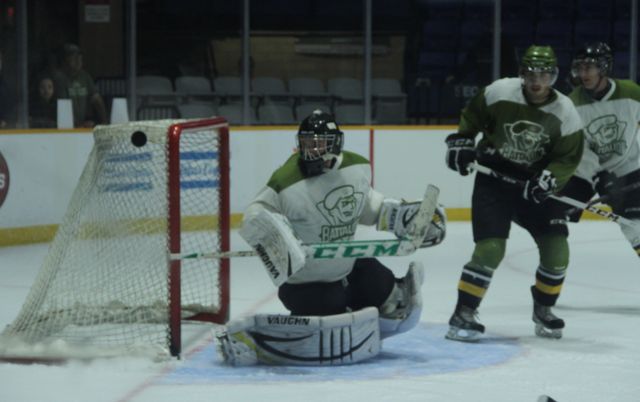
Arriving midway through the season, Jake Kment proved more than capable, posting a 6-0-0 record
Ranjan: Do different Battalion goaltenders have different coaching needs?
Rob Beatty: Everyone is different, and has a different skill set and are different to coach. Some you can be a little bit harder on, some you have to console a bit more and build their confidence. Sometimes you can’t be as blunt as you want to be because their characters are different.
As you know, goaltenders are often built a little bit different to begin with! I think the biggest thing is to make sure the lines of communication are open, and that those guys can rely on you as an ally. One shot can change the goalie’s confidence for the next three periods, and about how good you feel about yourself, and it’s good to have someone to talk to. If they can’t necessarily go to Stan, or Ryan, or Deaner, sometimes you become a camp counselor, sometimes you’re a guy just to vent at, sometimes you’re a tactician, and sometimes you’re just a friend, and I’m comfortable with all those roles.
Ranjan: Tell us about the pipeline. The Battalion selected a few goaltenders in both the 2014 and 2015 Priority Selections.
Rob Beatty: I’m encouraged. I’ve worked a little bit with Mathew Woroniuk so far this year in the off-season. I like what he brings and he’s a big, tall kid. We’re going to get him working on his feet. Early indications from him and his agent are that he may be playing in Pickering next year, so I’ll monitor that. In Matthew’s case he’s worked with the Franco brothers and Dave and I have a great conversation about the areas of focus and we share that information.
I like him, just from my brief time talking to him, and certainly watching him work over the summer these past three weeks. I’m encouraged that this kid is one of the kids that the North Bay fans are really going to like. If he works hard, and continues to develop, he’s going to get a great shot at it. He’s a pretty top-notch kid who’s got great size and a whole lot of upside.
I like the progress that Jake Kment has shown. Having a goaltender who comes in for Evan Cormier and all of a sudden goes 6 and 0. How do you argue that? And he played some pretty good teams, like Kitchener, down the stretch. So I’m encouraged about that.
Ranjan: Young goaltenders in North Bay have a great opportunity to sit in Section 9 and learn by watching Jake Smith, and also the visiting goalies, like Kenny Appleby. It must be tricky for a youngster to watch these great OHL goalies at Memorial Gardens, or NHL goalies on TV or YouTube, and then draw conclusions about a certain playing style, and feel they have to copy it...
Rob Beatty: It’s harder now than it’s ever been, because of the mediums that you’ve just mentioned. These kids get these exposures and think they’ve got to be as efficient as Carey Price; play as deep as Henrik Lundqvist; be as good at moving the puck as Ben Bishop…all those types of things. But I have to say, “Hey, you know what? Just be Jake Smith, or just be Jake Kment, or Evan Cormier, or Matej Machovsky.” You have to play the way you feel comfortable. Don’t get out of that, because you’re going to expose other parts of your game that are less efficient, or have greater risks.
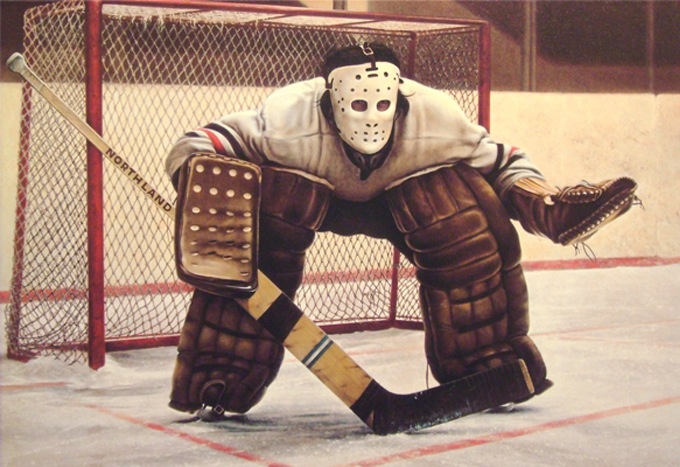
The late Ken Danby's iconic painting The Crouch hangs in Rob Beatty's office
Ranjan: What are the three most important things for a young, aspiring goaltender to keep in mind?
Rob Beatty: When I talk to every single parent of the kids I teach, it’s about the foundation. You have to have a good crouch. That crouch has been there forever. I’m a firm believer that that crouch position has to be really good. It’s the foundation of how we move and how we start: stick flat, hands in front, calves and spine angle the same, and being able to move. It’s about starting with the crouch, and playing how you want to play. So if you want to go down on every shot, go down on every shot!
My second point is build from your footwork out. Be really, really good on your feet. Be that skater. It’s not the old stereotype that the kid who can’t skate goes in net. No, not any more. Not even close. You have to understand how your edges work, you have to be extremely proficient at your footwork now. You have to be able to T-push; you have to be able to shuffle; you have to be able to do everything on a split second.
My third one is patience. Nowadays I don’t think goaltenders are as patient as what they should be. You have to remember that shooters still have to put the puck around you, and if you’re in good crouch position, and you have a good solid angle, as long as I’m there and square, they have to make a heck of a shot to try and beat you.
I do some work for the Maple Leafs in the offseason, and it’s funny but every once in a while I get to run into Johnny Bower and he comes up to me and says, “Rob, I don’t know what you’re teachin', but it’s a good thing. The crouch is the crouch is the crouch. Mine was solid then, and it’s still solid today!”
